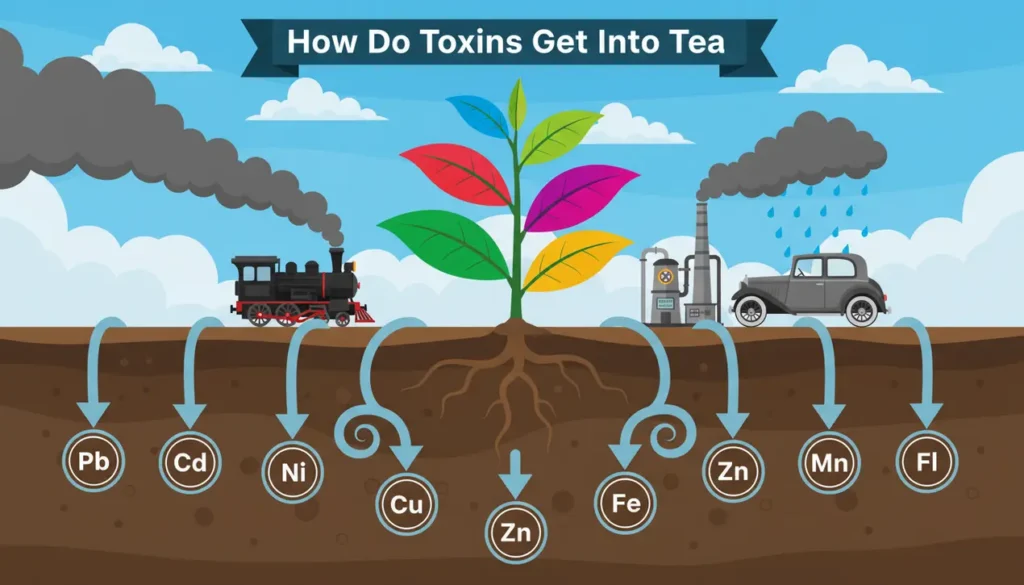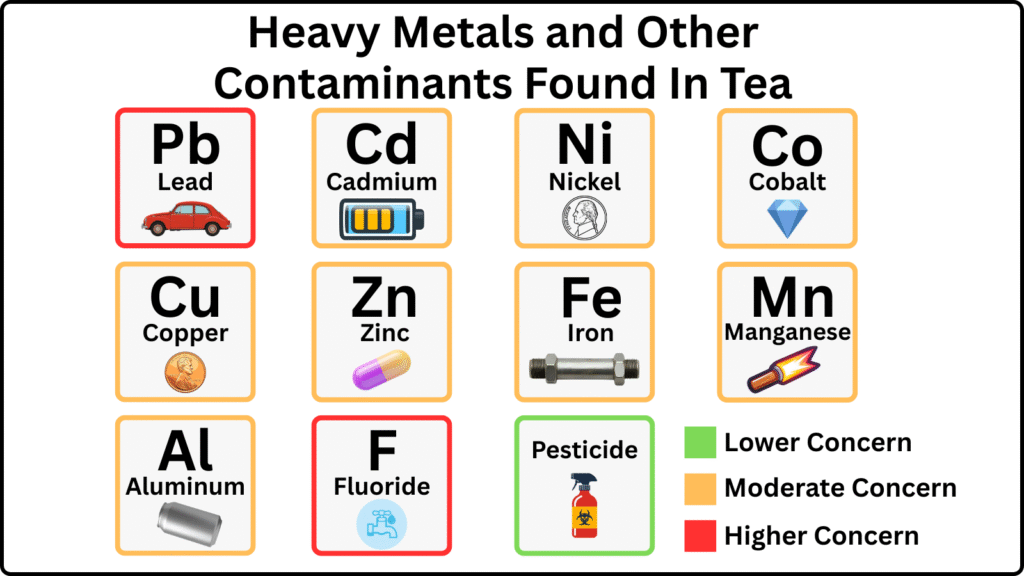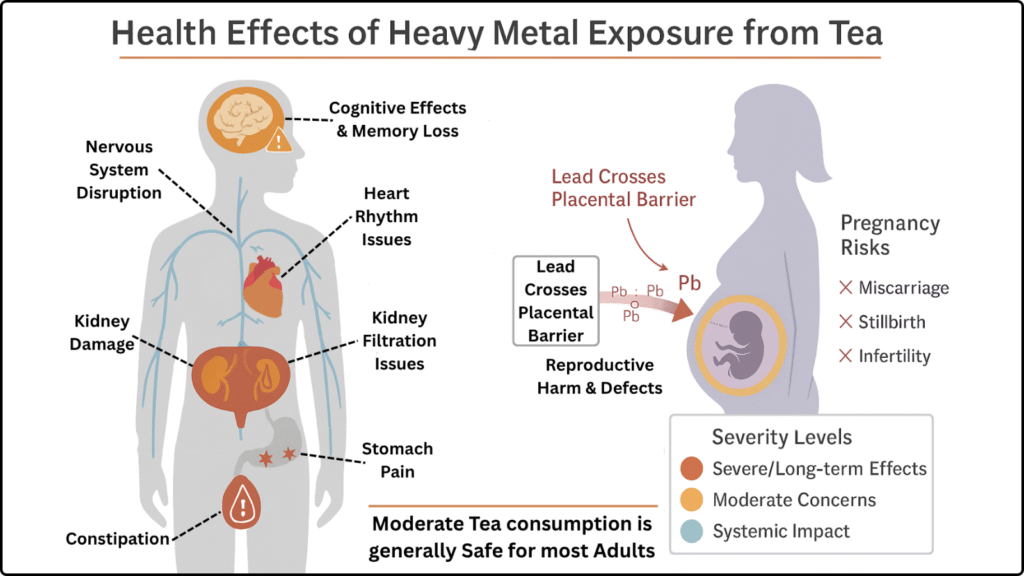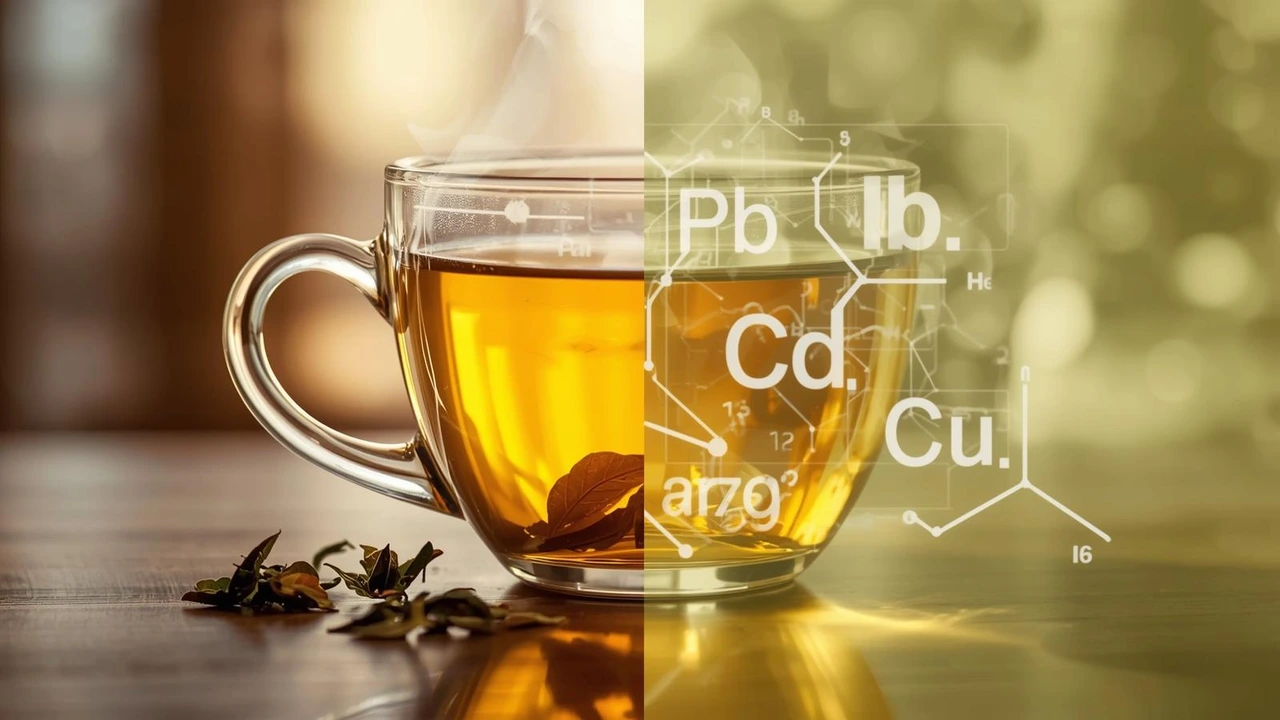How Healthy Is Your Morning Brew?
Most teas contain ingredients that are very beneficial, like antioxidants and flavonoids. Antioxidants can restore tissue and organ health as well as safeguard cells from further damage. Flavonoids can reduce your risk of heart disease, asthma, stroke, Alzheimer’s and even cancer. That’s why it may be so surprising to learn that your savory cup of tea could also contain toxins.
What toxins are in tea and why are they there?
In countries like China, where most tea is produced, there’s lead and heavy metals found in tea. This contamination comes from multiple sources: atmospheric pollution from industrial activities, contaminated soil from decades of pollution, and in some cases, even from processing equipment and packaging materials.
If you’re an avid tea drinker or even an occasional sipper, this may raise some concerns. We understand you may be worried, so we dug deeply into this topic to bring you the answers you seek.
How Do Toxins Get into the Tea?

While contamination has occurred in tea-growing regions worldwide, China’s toxic tea leaves issue remains one of the better-known cases. China banned the production of leaded gasoline in 1999, though it wasn’t fully phased out in all regions until the early 2000s. The global phase-out of leaded gasoline was finally completed in 2021 when Algeria, the last country using it, depleted its supply.
Leaded gasoline, also known as tetraethyllead or TEL, was a common gas type from the 1920s through the 1970s. The United States created its Clean Air Act, which ceased the use of TEL gas in that country. The Clean Air Act only applied to states in the US, so the rest of the world was free to use TEL gas if they so desired. Many countries stopped using leaded gasoline in the 1980s and 1990s, but some persisted longer.
When major tea producers used TEL gas in the past, not all of it went into cars and other vehicles. Some leaked into the soil through atmospheric deposition. Studies show that automotive exhaust contributed nearly 80% of lead found in young tea leaves and 60% in older leaves. As the tea leaves grow in contaminated soil, they absorb these metals and can become toxic.
The longer tea leaves grow and mature, the more toxic they can become. That’s because their lead content increases as they become bigger—the rate of lead could be up to six times more than younger tea leaves. Since oolong and black teas are made with older tea leaves, these teas could contain higher levels of heavy metals than green or white teas.
Recent research confirms that lead isn’t the only concern. A 2024 study analyzing tea samples found that heavy metal contamination rates were below 3% for most metals, with copper and chromium being the most frequently detected. Current research shows average lead levels in Chinese tea at approximately 1.09 mg/kg, with most contamination concentrated in southwest China, parts of eastern China, and Shaanxi Province.
Interestingly, new research from 2025 shows that brewing tea may actually help remove lead from water. Tea leaves naturally adsorb heavy metals during the steeping process, with longer steeping times removing more contaminants. This doesn’t eliminate concerns about lead in tea leaves themselves, but it does suggest that the brewing process may reduce some exposure.
Which Countries Have Grown Tea with Elevated Metal Levels?
China is only one part of the world where tea has been found to contain metals, lead, and other toxins. Research has also identified heavy metal contamination in tea from various regions worldwide.
A study from Saudi Arabia tested retail herbs and teas for heavy metals and found that tea brands contained cadmium, lead, cobalt, nickel, copper, zinc, iron, and manganese. The tea leaves tested had the highest concentrations of manganese and the least amounts of cadmium and lead. However, this study is now over 20 years old.
More recent 2024 research from Iran found that while black tea infusions contained arsenic, cadmium, and lead, the levels posed no serious health concerns for both children and adults when consumed in typical amounts. A 2025 study from China’s Hangzhou area tested 120 green tea samples and found that none exceeded standard limit values for heavy metals, though all samples contained detectable levels of various metals with manganese being the most abundant.
The key takeaway: tea quality and safety have improved significantly in recent years, though contamination remains a concern that varies by region and producer.
Which Toxins Are in There?

You already know about how lead gets in your tea, but are there other toxins you should be on the lookout for? There are indeed. Here’s an overview.
- Cadmium: Cadmium is a type of metal that’s known for being whitish-blue in appearance. It’s also softer than many metals. Most often, cadmium is used to make televisions and batteries. It can also create nuclear fission.
- Cobalt: Located near the crust of the earth is cobalt. This metal is grayish-silver and is much harder than cadmium if smelted. The term cobalt blue refers to the metal, which can be used to add color to glass, paints, jewelry, and other consumer items.
- Nickel: Known as a transition metal, nickel is also whiteish-silver. The main difference in terms of looks between it and cobalt is its golden sheen. There are several nickel compounds, including Nickel (0), Nickel (I), Nickel (II), Nickel (III), and Nickel (IV).
- Copper: A common metal that was once used to make pennies, copper has a golden-brown color. It can also be orange/pink. Copper goes into thermocouples, strain gauges, other coins, jewelry, and to conduct electricity and heat.
- Zinc: Zinc comes from the crust of the earth. It can be mined to produce sphalerite, a zinc ore that’s also called zinc blende. While zinc is indeed a dietary supplement, it should only be consumed as directed.
- Iron: Iron is found in many places, including the crust of the earth. It’s a sturdy building material that is used for cast-iron and/or wrought-iron applications.
- Manganese: Without manganese, we wouldn’t have stainless steel or other metal alloys. That’s because it keeps steel from corroding and rusting. If you ionize it, manganese can produce various colors.
- Aluminum: More recent research has identified aluminum as another metal of concern in tea. Studies have found elevated aluminum levels in some tea samples, particularly in certain regions of China.
- Pesticides: Pesticides remain a concern in non-organic tea. While organic tea must undergo a stricter preparation process without synthetic pesticides, even organic teas can be contaminated through pesticide drift from neighboring farms. In 2024, East West Tea Company recalled nearly 900,000 bags of Organic Yogi Echinacea Immune Support tea after detecting pesticide residues above action levels, highlighting that even organic certification doesn’t guarantee complete protection.
- Fluoride: Fluoride is another substance found in tea. There are higher fluoride levels in older tea leaves, much like lead levels. Recent research has sparked debate about fluoride’s neurotoxicity. A 2024 National Toxicology Program monograph concluded with moderate confidence that higher fluoride exposures (above 1.5 mg/L in drinking water) are associated with lower IQ in children, though this doesn’t specifically address the fluoride levels used in US community water fluoridation (0.7 mg/L). Black tea can contain 1.6-6.1 mg/L of fluoride, with an average of 2.5-3.3 mg/L. This is particularly concerning for pregnant women and young children.
How Do These Toxins Affect the Body?

Consuming a cup or two of tea with the above toxins in them does not mean you’ll necessarily have ill health effects. According to guidelines like the Safe Drinking Water and Toxic Enforcement Act of 1986 or Proposition 65, California sets a safe harbor limit of 0.5 micrograms of lead per serving to prevent reproductive harm. However, these limits are often lower than what naturally occurs in many fruits and vegetables.
For most adults, moderate tea consumption (3-4 cups daily) is considered safe. However, consuming excessive amounts could lead to overexposure to lead and fluoride. The CDC notes that lead overexposure may cause symptoms like body weakness, feet and hand tingling and pain, memory loss, no appetite, irritability, headaches, exhaustion, constipation, and stomach pain. Those symptoms are short-term only. Long-term, you could have brain and kidney damage, anemia, or even death.
If you are pregnant, lead can cross the placental barrier. This leaves the nervous system vulnerable, potentially causing defects in a growing baby. As a mother, you could also experience infertility, stillbirths, and miscarriages from too much lead. That’s why it’s recommended you limit tea consumption if pregnant and avoid black and oolong teas which have higher levels of both fluoride and potentially lead.
Regarding fluoride, recent research has raised concerns about potential neurodevelopmental effects, particularly during pregnancy and early childhood. Studies have found associations between higher maternal fluoride exposure and lower IQ in children, though the evidence is still debated and primarily comes from areas with naturally high fluoride levels exceeding 1.5 mg/L. Pregnant women who drink tea regularly should be aware that their fluoride exposure can increase significantly.
How to Tell If Your Tea Is Toxic
There’s no way to tell if your tea is toxic by taste or appearance, unfortunately. All you can do is research the types of teas you drink and stay informed about toxins and metals in this beverage.
Remember that organic certification helps reduce pesticide exposure, but it doesn’t eliminate heavy metal contamination since metals are naturally present in soil. Several tea brands now offer third-party testing for contaminants including heavy metals, pesticides, and microbes.
Brands to approach with caution (based on past testing showing elevated pesticide or heavy metal levels):
- Lipton
- Twinings
- Tetley
- Celestial Seasonings
- Tazo
- Teavana
Safer alternatives (brands known for third-party testing and quality control):
- Pique Tea (triple toxin screened)
- Numi Tea
- Traditional Medicinals
- Mountain Rose Herbs
- Art of Tea
- Choice Organic Teas
- Rishi Tea
- Republic of Tea
- Buddha Tea
If you can, buy teas that are transparently sourced and third-party tested for heavy metals and pesticides. Green and white teas generally have lower levels of fluoride and heavy metals compared to black and oolong teas since they’re made from younger leaves. Otherwise, consume moderate amounts—generally 3-4 cups per day for most adults, and just 1 cup of green or white tea for pregnant women.
Additional tips to reduce your exposure:
- Choose loose-leaf tea over tea bags when possible
- Don’t steep tea for excessively long periods (5-10 minutes is typically sufficient)
- Opt for organic certification to minimize pesticide exposure
- Look for brands that provide third-party testing results
- Vary your tea types rather than drinking only one kind
- Consider white tea, which has the lowest fluoride levels of all true teas
Conclusion
Teas produced in various parts of the world may contain heavy metals, with lead, aluminum, and cadmium being the main concerns. Lead contamination primarily comes from atmospheric deposition and contaminated soil, though the global phase-out of leaded gasoline in 2021 should help reduce future contamination. As tea leaves mature, lead and fluoride levels increase.
Pesticides and fluorides are also found in some teas, including organic ones. Too much lead in the body could cause death at worst and pain and discomfort at best. While debates continue about fluoride’s effects at various exposure levels, emerging research suggests pregnant women and young children should be particularly mindful of their fluoride intake from tea.
The good news is that tea safety has improved significantly over the past decade. More brands now conduct rigorous testing, and contamination rates have generally decreased. While there’s no way to taste metals, pesticides, and other toxins in your tea, by being a savvy consumer, choosing reputable brands, and doing your homework, you can sip more safely. The key is moderation, variety, and choosing quality over quantity.

Leave a Reply